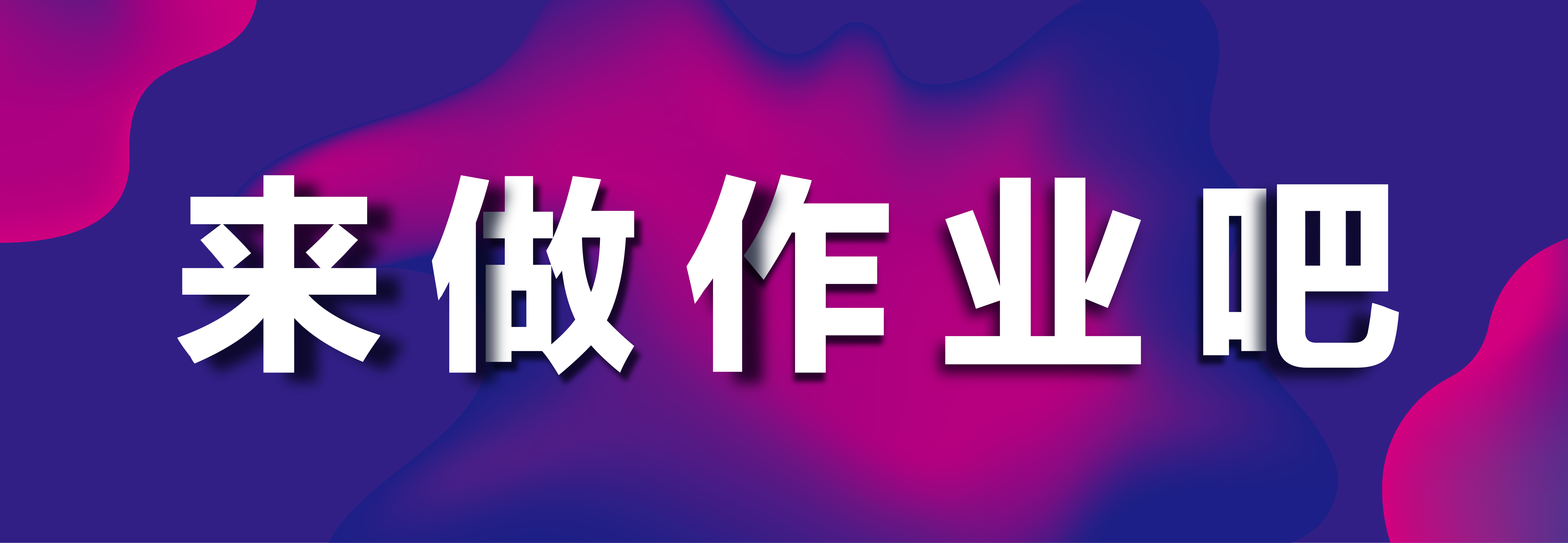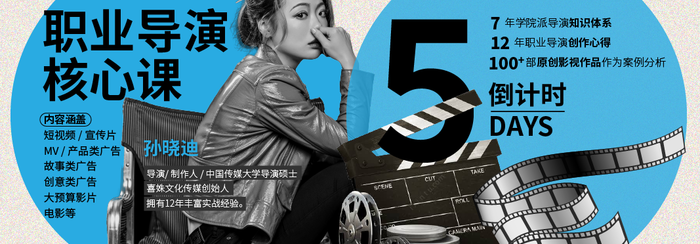跟ASC杂志学英语 | 第二期:《碟中谍6》幕后:两分钟的一镜到底背后有多少准备工作?
对幕后工作做来说,ASC是一本很好的杂志,影视工业网一直在做该杂志的汉化工作,而有一部分摄影师如中伟,一直阅读的是英文原版,当他知道这件事后就想,我们为何不专门开设这样的一门课程,教摄影师们学习英语?在电影全球化的今天,摄影师们学好英语,对生活和工作都有帮助,于是有了我们今天的课程。
中伟:荷兰摄影师,2009年进入北京电影学院摄影系电影摄影专业学习,于2013年以专业第一的成绩毕业并留校,在摄影系国际班任教。作品:电影《少女哪吒》、《追·踪》;短片作品《她》《绽放》。个人代表作还包括《魔轮》《重遇涅槃》。
黄心懋:国际电影监制,电影制片人。毕业于美国沃顿商学院MBA,曾在博纳影视,领航资本,中广有线传媒集团,美商中经合创投集团,美商帝杰/瑞⼠信贷投资银⾏担任高管和投资主管。
学习准备建议:笔记本电脑,边看直播边看杂志,也方便你划词做笔记。
今天学习的内容是ASC杂志的9月刊,《逐影全球》(global pursuit)栏目(下),带你走进《碟中谍6:全面瓦解》的幕后。(杂志地址:https://cinehello.com/boards/2094)
上期回看:https://cinehello.com/videos/15406
图注:
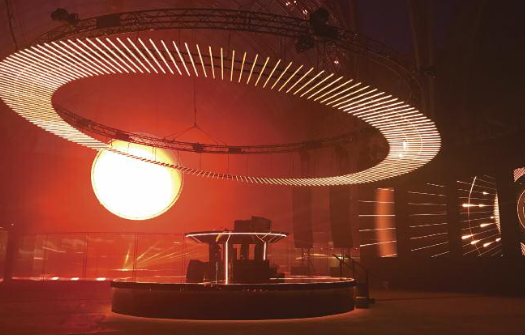
Inside the Grand Palais in Paris, Hardy worked with gaffer Martin Smith and his team to realize a massive lighting ring above a DJ’s booth
巴黎大皇宫内,哈迪同灯光师马丁·史密斯及其团队合作,在DJ台

and to erect a vertically oriented source designed to feel like an artificial sun (above)
上方安装了大型照明环,并设置了竖立光源模拟人造太阳效果(见上图)。
19段:
The first of Fallout ’s two major aerial sequences is an extended skydiving scene that takes place over Paris but was shot in Abu Dhabi and Dubai. “Essentially what we planned to do was show Tom jumping out of a C-17 military airplane at 25,000 feet and skydiving all the way until he lands on the roof of the Grand Palais in Paris — all in one shot,” Hardy explains. “Of course, there are elements there that, for practical reasons, meant that the single shot had to be multiple shots stitched together, but the same principle applied.”
stitched together:将镜头拼接在一起;stitch意为缝纫。
skydiving scene:跳伞戏
《全面瓦解》中有两段于空中拍摄的重头戏,其中一个是发生在巴黎上空的跳伞戏,但这实际是在阿布扎比和迪拜拍摄的。“我们最初是想呈现汤姆从飞行在25000英尺高空的C-17军用飞机中一跃而出,一路自由落体, 最后打开降落伞着陆到巴黎大皇宫屋顶——一镜到底。”哈迪解释道:“当然,由于一些客观因素,这个镜头不得不由多个镜头拼接而成,但这并不影响一镜到底的视觉呈现。”
20段:
The sequence begins with Huntand CIA Agent August Walker (Henry Cavill) inside the C-17, prepping for their high altitude, low opening (HALO) jump. “We started choreographing it early on, all the way from marking out the dimensions of a C-17 on a stage to figuring out how to shoot it like it was one elegant Steadicam shot,” Hardy recalls. “We choreographed the entire sequence [both the scene inside the C-17 and the skydiving action] over a period of two months, establishing the camera positioning, lens and stop choice — pretty much everything — and we worked closely with [skydive camera operator] Craig O’Brien.”
choreograph:设计舞蹈动作、为...编舞,文中指编排跳伞戏
camera position:机位
skydive camera operator:跳伞戏掌机
片段一开始,亨特及中情局特工奥古斯特·沃克(亨利·卡维尔饰)就 在C-17飞机内为HALO跳伞(高空投 下低空开伞)做准备。“我们早早便开始编排了,起先时就在摄影棚中标出 C-17的空间尺寸,以此弄清如何拍摄 坦尼康镜头,”哈迪回忆道:“我们为 整个片段安排好了走位,包括机舱内 的场景以及紧接其后的跳伞动作戏。 我们为此足足花了两个月琢磨机位、 镜头和光圈档位的选择——所有东西都考虑到了。并且我们与特技跳伞摄 影机掌机克雷格·奥布莱恩(Craig O’Brien)密切合作。”
21段:
This sequence begins inside the cargo plane as it approaches the drop zone. While suiting up, Hunt and Walker discuss their plan; the lights in the cargo hold go red, then the cargo door opens. Hunt walks toward the open door, takes a look at the ominous sky below, then comes back to reevalu- ate the jump with Walker, who instead runs past Hunt and leaps out of the plane. Hunt then follows, running to the open door to begin his own descent and catch up with Walker.
片段开始时,我们置身运输机内部,运输机正在接近伞降区域。亨特和沃克一边穿跳伞服一边商量行动计划;随后舱内指示灯变红,舱门打开。亨特朝舱门走去,看了看阴郁的 天空然后退回舱内,打算与沃克重新讨论跳伞事宜。沃克此时却越过亨特,朝舱门跑去,一跃而出。亨特紧随其后,跑向舱门,往外一跳,跟上沃克的步伐。
22段:
“Everything prior to the lights turning red was shot on film by the main unit inside the C-17 on an airfield in the U.K.,” Hardy reveals. “When the lights turn red, I switched the format from film to Imax digital, using the DXL — still shooting inside the C-17 on an airfield in the U.K. The doors of the plane open, and as Tom walks up to the precipice, we used a 50-foot Tech- nocrane inside the C-17 to follow him and rise up to look out to see the storm below; for this, we lit a huge greenscreen that was erected on the tarmac. Once Tom returns to speak to Henry, there is a brief exchange, at which point Henry leaves the plane — and it is here that the switch to the [skydiving] shot is made, only a few seconds before Tom jumps from the plane.”
precipice:悬崖,文中指机舱边缘
tarmac:飞机跑道
greenscreen:铝模
“灯光变红前的所有场景都是主摄制组在英国某机场的C-17运输机舱内用胶片拍摄的。”哈迪透露道:“当灯光变红时,拍摄格式就从胶片转为数字Imax,使用DXL摄影机——仍旧在英国某机场的C-17运输机舱内拍摄。机舱门打开,汤姆走到舱门边缘时,我们用50英尺长的伸缩炮跟拍他,然后抬高机位拍摄舱外的风暴。 为此,我们打亮了竖立在沥青地面上 的一块巨大绿幕。汤姆回头跟亨利说 话,寥寥几句后,亨利就跳机了——就是在这一刻,汤姆跳机前的几秒钟,我们正式转入了设计好的跳伞镜头。”
23段:
The scene was scripted to happen at night, but Hardy recalls pointing out that since the actors would be wearing black jumpsuits with only the lights in their helmets to illuminate their faces as they were diving, “we would only really see their faces against blackness, and that wouldn’t work.” He therefore urged that the scene instead be shot around sunset. At that time and from that height, Hardy explains, “you can see the curvature of the Earth. Even a half hour or 40 minutes after sunset, you can still see a glow on the horizon. From a visual standpoint, that was the best condition in which to do the jump.”
curvature of the Earth:地球的弧度
illuminate:打光
照剧本安排,该场景应发生在夜间。但据哈迪回忆,演员身穿黑色跳伞服,跳伞时只有头盔的灯能够照亮 面部。“只能看到黑暗中的两张脸。 这可行不通。”于是哈迪要求在日落时分拍摄这场戏。他解释道:“那样的时间,那样的高度,尚能见到地球的弧度。即便在日落三四十分钟后, 还能看到地平面上闪着亮光。考虑到视觉效果,此时跳伞条件最佳。”
24段:
“Tom and Henry both had helmets with lights,” Smith explains. “We had to design a robust system that was intrinsically safe, as the masks were under a constant oxygen flow. We decided to use LED — 5mm-wide Slim Version, 9.6 watts per meter, warm white. [Action props supervisor] Toby Shears had the task of trying to position the LED with just enough diffusion to wrap around the face, but without emitting light into the actor’s eyes. The LED controls, drivers and battery pack were handmade by my electronics guy, Steve Coles.
diffusion:柔光
Action props supervisor:动作道具顾问
“汤姆和亨利都戴了配灯的头盔。”史密斯解释道:“我们必须要设 计一个从根本上确保安全的系统,因决定使用5毫米宽的Slim Version LED灯条,每米功率9.6瓦,发暖白光。动作道具顾问托比·希尔士(Toby Shears) 负责调整灯条位置,确保其发出的柔 光刚好包围角色面部,但光线不会射 向演员眼睛。LED灯的控制器、驱动 器和电源包都是我的电工朋友史蒂夫· 科勒斯(Steve Coles)手工制作的。”
25段:
“The lights had to be tested in an oxygen-rich laboratory test facility to satisfy our stringent safety protocol,” the gaffer continues. “After approval, we then had the task of hiding the cables from our battery pack — which went in a little pouch that had been designed on the back of the parachute — all the way up the back of the parachute, inside the padding that goes between the actual chute capsule and the back of the padding support. We had to figure that out with the stitch master, Ray Armstrong, the only person authorized to alter the para- chutes. That was a big issue, looking after those lights in the helmets, setting levels, changing batteries after each jump, and maintaining and fixing anything that might come loose. A last-minute safety request was to have an inline switch fitted so the actors could switch off the lights as they neared the landing zone, giving their eyes time to adjust to the ground lighting.”
safety protocol:安全保障
gaffer:领班,文中指灯光师、照明师
A last-minute:开拍前的一刻
“灯光必须要在富氧实验室内进行测试,以满足严格的安全要求。”灯光师史密斯说道:“安全性得到保证后, 我们的任务就是安装电缆,电缆和电源包不在一处,电源包装在降落伞包背面的一个小袋内,而电缆则要一路 走线到伞包上方,埋在伞囊和衬垫托之间的衬垫内。我们需要缝合师雷·阿姆斯特朗(Ray Armstrong)的帮助, 只有他获得授权可以改造降落伞。要注意头盔的灯、设置规格、每跳伞一次更换一次电池、设备养护、要是有什么东西松动了得维修,这些事项都是至关重要的。一个在最后关头才提出的安全要求是要给这套灯光系统设置内联开关,这样演员在接近着陆点时才能够自行关闭灯光,使眼睛有时间适应地面的光线情况。”
图注:

Hardy and McQuarrie plan their coverage of Cavill and Cruise.
哈迪和迈考利调试卡维尔和克鲁斯的入镜范围

Above: One of Hunt’s objectives in the Grand Palais is to make contact with the White Widow (Vanessa Kirby).
上图:亨特进入大皇宫的目的之一是和“白寡妇”(凡妮莎·柯比饰)接头。
26段:
Working with skydive stunt coordinator Allan Hewitt and his crew, Cruise had been skydiving in prepara- tion for the real HALO jump when his training was waylaid by two factors: a “savage” winter in England, according to 1st AC David Penfold, and the broken ankle that forced the production into hiatus. The filmmakers then changed tacks, focusing their attention on a wind-tunnel set they had already built onstage at Leavesden Studios, where Cruise could round out his training and work through the jump sequence’s choreography with Cavill’s skydive double, and where the production had already anticipated shooting portions of the skydiving action.
waylaid:waylay 埋伏,文中指耽误
“savage” winter in England:形容英国的冬天特别冷;savage意为残酷的,荒凉的
1st AC:摄影大助
skydive double:指跳伞戏替身
克鲁斯同跳伞特技指导艾伦·赫威 特(Allan Hewitt)及其组员合作期 间,一直在练习跳伞,为真正的 HALO跳伞做准备,但他的训练却因两件事受阻,其一是第一摄助大卫·彭弗德(David Penfold)提到的英国的凛冬,其二是他的脚踝受伤,摄制被迫暂停。电影主创于是改变了策略,打算专注于在风力机内拍摄,利维斯登影棚内已安装好了这一设施,克鲁斯可在此完成跳伞训练,并与卡维尔一起完成跳伞戏的编排。剧组也已经做好了在此拍摄跳伞动作戏的准备。
27段:
Eventually, the filmmakers decided to try shooting the entire HALO sequence in the wind tunnel. To that end, Hardy explains, the crew strove to “orchestrate lighting patterns that would describe the jump from the beginning, being up at 25,000 feet with the corpuscular light still in the sky, going through a storm cloud, and then emerging from the cloud and seeing the glow of the lights of Paris below.”
机内拍摄HALO跳伞片段的全部镜头。为此,哈迪解释道:“剧组努力设计灯光模态,试图模拟这一系列效果:在两万五千米的高空,天际微微泛出红光,跳伞者一跃而下,穿透暴雨云,而后又从云中现身,望向地面,只见巴黎城中灯火闪耀。”
28段:
Despite the lengths to which they went, the filmmakers weren’t completely satisfied with the sequence, and Cruise remained convinced that the best way to shoot the HALO jump was to do it for real. Accordingly, the production made its way to Abu Dhabi to prepare for and shoot the sequence as an actual skydive. “I oversaw [a number of] practice jumps in Abu Dhabi to ensure they were jumping at the specific time of day I’d requested so that narra- tively it flowed from the airfield through to Paris,” Hardy notes.
尽管拍摄工作进行多时,电影主创们对这段跳伞戏仍然不甚满意。克鲁斯则坚信拍摄HALO跳伞最好的方式就是实拍。于是剧组去到阿布扎比,准备实拍工作。哈迪表示:“我在阿布扎比监督了多次跳伞练习,想要保证他们在一天中我要求的特定时段跳伞,这样一来,叙事上才能从机场自然地流转到巴黎。”
图注:
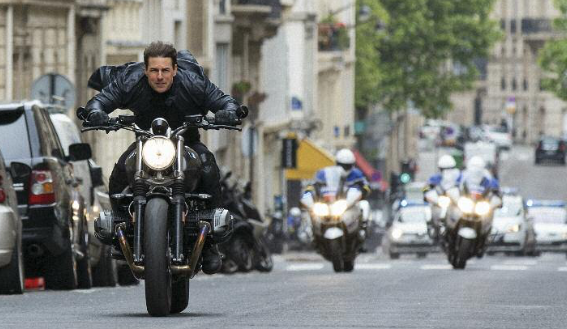

Cruise maneuvers a motorcycle through the streets of Paris during a high-speed chase sequence.
克鲁斯在巴黎街头高速驾驶摩托车,上演机车追逐战。

The director confers with Cruise while working on a later point in the chase, after the actor’s character has ditched the motorcycle and taken the wheel of a sedan.
上图:追逐战后期,亨特弃摩托车坐上一辆小轿车,导演给克鲁斯讲戏。
29段:
Before the actual shooting commenced, Hardy had to step away on paternity leave, and director of photog- raphy Fraser Taggart came aboard “as a stand-in, should anything arise,” says Hardy. “Everything technically and creatively was already in place.” A veteran 2nd-unit cinematographer, Taggart had previously worked with McQuarrie and Cruise on Edge of Tomorrow (AC July ’14), which McQuarrie wrote.
paternity leave:陪产假
2nd-unit:B组
veteran:经验丰富的人
正式开拍前,哈迪因请陪产假提前离组,摄影指导弗雷泽·塔格特 (Fraser Taggart)进组暂代其职。哈 迪说:“若是出现什么问题,都由弗雷泽处理。技术和创意层面的事务都 已安排妥当了。”塔格特是一位经验丰富的第二摄制组摄影指导,曾与迈考利和克鲁斯合作拍摄过《明日边 缘》(14年7月刊),迈考利担任该片编剧。
30段:
While preparing for the shoot, Hewitt and his stunt team worked alongside O’Brien and Penfold to design a jacket that O’Brien could wear while skydiving and that would house all of the requisite accessories for the camera — in this case a Red Weapon Dragon 6K with a 24mm Primo 70 prime. Hardy says he opted for this camera and lens combination “partly for size — and the [Primo 70] lens choice aligned with what we had established for the rest of the Imax sequences in the film.” The HALO sequence was entirely shot at 6K.
准备拍摄期间,赫威特及其特技团队同奥布莱恩、彭弗德合作设计了一款夹克,可供奥布莱恩跳伞时穿着,这个夹克可以收纳所有摄影机所需的必要配件。在这个场景用到的摄 影机是Red Weapon Dragon 6K,装配 24mm Primo 70定焦镜头。哈迪表示,选用这对摄影机及镜头的组合, “有一部分原因是它们体型紧凑,并且选用Primo 70镜头拍出的画面,也将与影片中其它已经确定的Imax片段画面相匹配。”整个HALO跳伞片段都 是以6K分辨率拍摄的。
31段:
“Everything was powered by one single battery,” Penfold explains, “all the accessories on the camera plus a trans- mitter.” When Penfold had to briefly step away from the production, 1st AC Dean Thompson filled in. “Dean came up with the idea that we redesign the Arri Master Grip to make it work for the skydiver, so he could pull focus,” Penfold continues. “Then Pete Swar- brick at Panavision U.K. took over and reconfigured that accessory so that it was safe for Craig to pull focus with his left hand.
pull focus:跟焦
“整套设备都是靠一块电池供电的,”彭弗德解释道,“包括安在摄影机上的所有配件和一个无线图传发射 器。”当彭弗德不得不短暂离开剧组时,第一摄助迪恩·汤普森(Dean Th- ompson)补替了他的位置。“迪恩想出一个点子,让我们改装Arri的 Master Grip镜头控制手柄,使其可以适用于跳伞戏的拍摄,这样克雷格就可以跟焦了。” 彭弗德继续说。“后来Panavision英国分部的皮特·斯瓦布里克(Pete Swarbrick)接手了这项工作,改装了该配件,于是克雷格用左手跟焦也能保证安全了。”
32段:
“We showed Craig O’Brien how to pull focus, and we limited the focus ring on the lens to give him limits from 3 feet to 30 feet, so that he didn’t have a massive run between the two limits,” the 1st AC recalls. “It was hard, because he was focusing without seeing the scale. But it worked in the end. He got used to the whole process.”
“我们示范给克雷格·奥布莱恩看,教他应该如何跟焦。我们把镜头跟焦环的范围限制在3至30英尺之间,这样他就不必面对过大的对焦行程,” 迪恩·汤普森回忆说,“这不容易,因为他对焦的时候根本看不到镜头上的刻度。但最后还是成功了。他习惯了整个过程。”
33段:
In addition to O’Brien having to learn how to pull focus with the system, Cruise had to learn to stay at certain distances from the operator while both were plummeting toward the ground. “It was all about practice,” Penfold says. “They did six or seven jumps a day, plus the hero jump.”
除了奥布莱恩得学习如何在那套 摄影系统上跟焦外,克鲁斯则还要学习如何在自由落体时跟掌机保持一定距离。“熟能生巧。”彭弗德说道: “他们每天要练习六七次跳伞,外加那次在规定时段的跳伞排练,英雄之跳。”
34段:
Three or four jumps were done in the morning, and the rest in the after- noon and evening, with the hero jump happening at the prescribed time “15 minutes after sunset,” Smith details, with the skydivers falling “into darker blue night as the freefall takes place.” Those jumping out of the plane were Cruise; Cavill’s stunt player; O’Brien; plus two or three safety and support jumpers, one of whom wore another helmet camera so the practice jumps could be reviewed and performances tweaked.
“英雄之跳限定在日落后十五分钟内练习。”史密斯详细描述,“跳伞者坠落跌进深蓝的夜空。”跳出机舱的有克鲁斯、卡维尔的特技替身演员、奥布莱恩、以及两到三位提供安全保障与支持的跳伞教练,其中一位教练头盔上会携带另一个摄影机,这样大家便可以重看跳伞练习录像,以便下回微调动作。
35段:
In lieu of a single take for the entire HALO sequence, the filmmakers opted to capture the action in three sections that they shot in order, and the first of which Penfold describes as “the most complicated.” This first stage begins inside the cargo plane as Hunt runs toward the open cargo door to begin his own descent and catch up with Walker. “At this point Tom Cruise was running toward the operator and they jumped together — the operator back- wards,” Penfold explains.
HALO跳伞片段不是一镜到底拍摄而成,而是分三段逐一拍摄。彭弗德认为第一部分最为复杂。这一部分拍摄亨特在机舱内,朝着敞开的舱门奔去,预备跳伞,试图跟上沃克。 “这时克鲁斯朝掌机方向跑去,然后两人双双跳伞,掌机是倒退着跳出去的。”彭弗德解释道。
36段:
The camera was mounted to O’Brien’s helmet; the camera system’s single battery provided power for one take and no more. “We were very careful with the timing because we knew the battery would run out,” says Penfold.
helmet:头盔
摄影机被安装在奥布莱恩所戴头盔的顶部,摄影机系统的单个电池电量只足够进行一条的拍摄。“我们十分注意把握时间,因为电池会耗尽。”彭弗德说道。
图注:
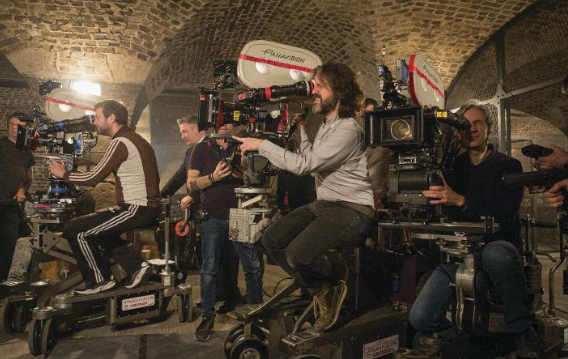
Hardy operates one of three cameras for a scene that finds the IMF team in a subterranean location in London.
哈迪操作三台摄影机其中一台,拍摄发现IMF团队身处伦敦一地下场所的场景。

IMF Secretary Alan Hunley (Alec Baldwin) awaits his agents’ arrival
IMF秘书长艾伦·胡恩利 (亚历克·鲍德 温饰)等待其手下特工们的到来。
37段:
For the action inside the plane, Penfold pulled focus remotely, from the cockpit; once O’Brien jumped out of the plane, focusing was then in his hands. “Once the operator jumped, I turned my equipment off and his system took over,” Penfold explains. The transition from inside to outside the plane also required an iris pull. “We were shooting inside at T2, and then we pulled to a T2.81⁄2,” Penfold details. “The DIT did the iris pull.” As the jump begins, the distance between O’Brien and Cruise immediately opens up, but Cruise quickly dives back into a close-up.“Then he leaves and Craig follows behind,” says Penfold, adding that as Cruise enters a cloud, “there’s a cut to our second stage.”
iris pull:跟光孔、光圈
拍摄机舱内动作戏时,彭弗德在驾驶室遥控跟焦。一旦奥布莱恩跳出飞机,跟焦的任务就转交给他了。 “只要掌机起跳,我就会关闭我这边的设备,他那边的系统就会接替运作。”彭弗德解释说。从舱内至舱外的转变还要求光圈值的调节。“舱内拍摄使用T2,舱外则调节为T2.8 1/2。”彭弗德做了具体说明。“光圈调节是由数字影像技师负责的。”一旦跳出机舱,奥布莱恩和克鲁斯二人就会拉开距离,但是克鲁斯很快又会拉近距离,形成特写的景别。“然后克 鲁斯会飞离这个构图,克雷格紧随其后。”彭弗德又补充,“克鲁斯进入云层之际,拍摄切至第二部分。”
38段:
The second stage transpires within the storm cloud provided courtesy of visual effects where Walker runs into trouble, forcing Hunt to his rescue. In the third stage for which the production moved from Abu Dhabi to Dubai the two exit the cloud, Hunt catches Walker, and the two tumble about as Hunt works furiously to replace Walker’s damaged oxygen tank with his own. “All of that was done in midair,” Penfold stresses. “The choreography of the second two stages was massive and very complicated.
第二部分是在视觉特效创造的风暴云中发生的,在这里沃克遇上了麻烦,迫使亨特前来解救。第三部分从阿布扎比转至迪拜进行拍摄。亨特与沃克离开云层,亨特抓住沃克,两人跌跌撞撞,亨特竭力用自己的氧气罐替换沃克的损坏的氧气罐。“所有动作都在半空完成。” 彭弗德强调,“这两部分的动作编排内容很多,并且十分复杂。”
39段:
“The camera became a little bit lighter after the first section because we took bits off,” Penfold continues. “The focus was still there, but there was no more pulling iris, and we didn’t need a transmitter.”
“第一部分拍摄完毕后,我们卸下了一些部件,因此摄影机的重量减轻了。”彭弗德说道:“对焦设备还在,但拆除了控制光圈的部件,而且也不需要使用无线图传的发射器了。”
40段:
For the final two stages, Penfold explains, “they did the same process,” with multiple practice jumps in the morning and afternoon leading to the hero shot. “The first section took a week, the second section took another week, and the third section took another week. It was summer and the days were getting longer, so the timing of the hero jump was going up by a minute or so each day — they were very precise.”
谈及后两个部分的拍摄,彭弗德解释道:“过程其实一样。”上午大量练习跳伞,下午则为特定时段的英雄之跳准备。“每一部分的拍摄耗时一周。时值炎夏,白昼渐长。因此每日练习英雄之跳的时限延长了一分钟左右——这个时机的限定非常严格。”
41段:
After landing on the roof of the Grand Palais, Hunt and Walker make their way onto a gantry inside — action that was shot with one Red Weapon Dragon 6K camera on a Stabileye rig and another on a Spydercam, as well as one handheld DXL and another on a crane.
handheld:手持型
crane:吊车、升降车、文中指摇臂
亨特和沃克在巴黎大皇宫屋顶着陆后,两人走向室内的一个台架。这一部分的拍摄用到了安装在Stabileye rig和飞猫上的两台Red Weapon Dragon 6K摄影机,此外还用到了两台DXL摄影机,一台手持,另一台安装在摇臂 上。
42段:
Inside the Grand Palais, Hardy sought a streaming-sun effect for the party that the secret agents have been tasked with infiltrating. “The end result,” Smith explains, “was a 50-foot- diameter circular truss that we hung in a vertical orientation in the Grand Palais, with a diffused warm-tone cinema- screen projection material on it. Then, we had 36 Robe BMFL Blade moving lights that were mounted on a truss that we had specially designed, engineered, and weight-load tested to hang like a clock face [some distance behind the cinema screen]. Desk operator Dan Walters flooded-out the moving lights and slightly diffused them to take the elliptical shape out of the beam angle, and then aimed them onto our projection screen.
infiltrating:渗透
Desk operator:文中指光控台操控人
巴黎大皇宫内,哈迪希望将身负渗透任务的秘密特工们参加一场派对密斯解释道:“最后我们把直径50英尺的环形桁架竖置于大皇宫内,上面铺着一张暖调电影银幕材质的柔光布。然后我们将另一个特殊设计、建造并经过重量测试的桁架如同钟面般悬吊起来,放置在银幕后方一定距离处。我们又在这个桁架上安装了36盏 Robe BMFL Blade移动灯光。”光控台操作员丹·沃尔特斯(Dan Walters)将 所有移动灯光调至最亮,并给它们加上轻微的漫射效果,以抵消其光束角度产生的椭圆形,再将它们指向那块银幕。
图注:
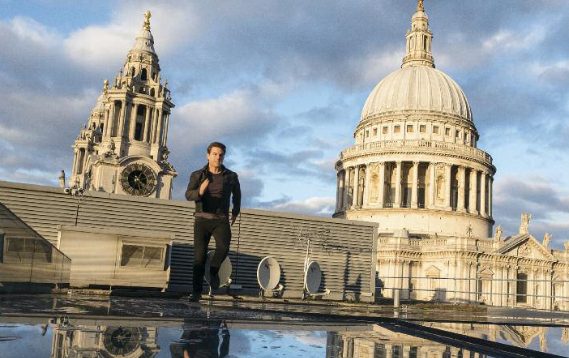
Events in London lead to a foot chase that involves landmarks such as St. Paul’s Cathedral.
伦敦徒步追逐戏中,亨特途经圣保罗大教堂等地标建筑。
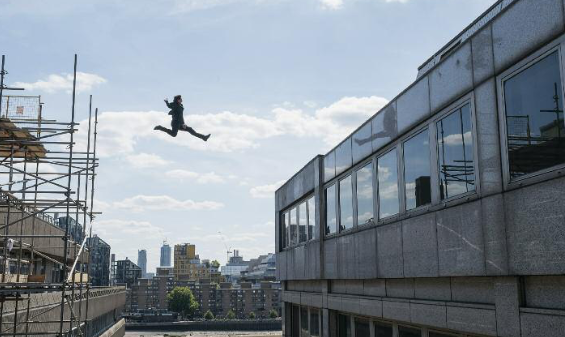
Hunt leaps toward another building. It was while performing this stunt that Cruise broke his ankle, forcing the production into a two-month hiatus.
hiatus:缝隙、文中指剧组停工
亨特跳向一大楼。在这场特技表演中克鲁斯摔伤了脚踝,拍摄被迫暂停
43段:
“In the middle of the ‘clock face,’ we had four [23.4K LRX] remote-head Scorpion lights hanging on a separate truss with double full Amber gel on those heads,” Smith continues. “We used the Scorpions when we were shooting down the far end of the Grand Palais, just to help the beautiful ‘sunlight’ travel deeper into the vast space of the Palais.
Amber gel:琥珀色色纸
“在这些‘钟面’的中间,我们安装 了四盏具有电控头的23.4K功率的 LRX Scorpion灯,悬挂在另一桁架 上,灯头上加装有两层满档的琥珀色色纸。”史密斯继续说,“在大皇宫内较远的另一头拍摄时,我们也使用了 Scorpion灯,这样美丽的‘日光’就能深入照进宫内的巨大空间。”
44段:
“We also had strobe lighting [with Martin Atomic strobes], more than 200 [Arri] SkyPanels, and 60 Sunstrip lights,” Smith continues. He adds, “We also had great projectors, video walls and lasers supplied and installed by Chris Cox at ITR London — seven huge Unilumin 3.9mm LED video walls, six Tripan lasers, and four 30,000-lumen Panasonic projectors. And we designed and built a bespoke 50-foot diameter truss to contain an immense light ring that hung over the DJ’s booth, with more than 200 6-foot- long fluorescent lighting tubes that all had to be programmed back to the lighting desk.” Those tubes, the gaffer notes, were arranged to look “like bicycle spokes or a wagon wheel.”
strobe lighting:闪灯
laser:激光
fluorescent lighting:荧光灯
“我们还用Martin Atomic频闪灯、 200多个Arri SkyPanel和60多盏Sunstrip 灯做出了闪烁的光效。”史密斯接着 说。他又补充,“我们还有非常好的投影仪、视频墙以及激光——七面巨的Unilumin 3.9mm LED视频墙、六 个Tripan激光灯和四个30000流明的Panasonic投影仪,这些都是由ITR London的克里斯·柯克思(Chris Cox) 提供及安装的。我们设计并定制了一 个直径50英尺的桁架,用以悬挂一大 型灯光环,该灯光环布置在DJ台的上 方,由超过200条6英尺长的荧光灯管 组成,由灯光控制台控制。”史密斯 说,“灯管排布的形状就像自行车辐 条,或者说像马车的车轮。”
45段:
After their journey through the Grand Palais, Hunt and Walker become involved in a daytime heist that quickly turns into a high-speed chase through the streets of Paris. The action in Paris involved some aerial shooting with helicopters, from which, Steel notes, “we used the spherical 12:1 Angenieux Optimo [24-290mm (T2.8)].”
离开大皇宫后,亨特与沃克卷入了一场日光下的阻截,这很快变成了巴黎街道上的高速追逐。巴黎的戏份 动用了数架直升机进行航拍。斯蒂尔透露:“我们使用了12:1 Angenieux Optimo 24-290mm (T2.8)球面变焦镜头。”
46段:
The chase begins with the secret agents in a truck that becomes increasingly battered as the sequence progresses. “That meant we were left with less and less of a truck to rig from,” says Phillips. “Plus, whatever camera mount we rigged had to be able to take the full brunt of any impact, so the points of contact for the camera had to be bolted in. Rigging grip Jean Chesneau made a number of brackets for various parts of the truck that would bolt in — but we still went through a few pieces of truss.”
rig:架设
追逐开始时,两位特工在卡车中,随着片段的进行,卡车被撞的越来越残破。“这意味着卡车上留给我们安装设备的空间越来越小,”菲利普斯 说。“再加上,我们不管安装怎样的摄 影机座,它都必须能够承受所有碰撞 带来的冲击力,所以摄影机的安装点 必须要有螺栓加固。装置器械师让·谢 诺(Jean Chesneau)在卡车各部位 制作安装了大量可用螺栓加固的支 架,但我们在拍摄中依旧使用了部分 桁架结构。”
47段:
Ditching the truck, Hunt then takes off on a motorcycle, soon finding himself racing against traffic around the Arc de Triomphe at the Western termi- nus of the Champs-Élysées. French authorities closed the famed roundabout to traffic for all of 90 minutes, during which the production had to capture everything it could.
抛弃卡车后,亨特骑上一辆摩托车,在香榭丽舍大街西端的凯旋门附近逆着车流快速行驶。法国政府部门封锁此著名环形交叉路口90分钟,在这期间剧组需要尽可能地捕捉所需镜头。
图注:

In the second of Fallout’s major aerial sequences, Hunt scales a rope up to a helicopter that’s in flight
《全面瓦解》主要空戏第二个场景,亨特顺着绳索爬上飞行中的直升机
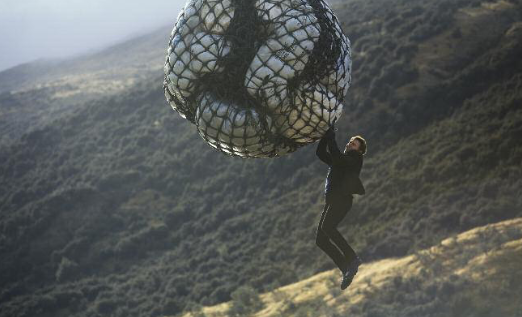
loses his grip but catches himself on the chopper’s cargo
不慎失手坠下,所幸抓住了运输包

and then climbs the rope again, this time successfully
再次攀索而上,终获成功
48段:
The street lockoffs presented quite a challenge,” says Phillips. “We had a very limited window of time to shoot, so stopping to re-rig camera positions on tracking vehicles or cars was not going to work. For the chase sequences, we used a combination of tracking bikes, quads, a Pursuit arm [with an Arriflex 435], and hard mounts on the hero BMW. With the exception of the Pursuit arm, we used multiples of everything. One bike was rigged at the front with a Mini Libra and [an Arriflex] 235 camera, and another bike was rigged with the same, but out the back, each with its own rider. Our stunt coordinator [Wade Eastwood] had been developing an electric tracking bike for some time that enables you to change camera height at the touch of a button; that tool came into its own on this job.”
“道路封锁造成了不小的挑战,” 菲利普斯说道。“拍摄时间有限,停下来重新安装跟拍车上的镜头根本行不 通。为了拍摄追逐镜头,我们结合利用了跟拍摩托车、四轮摩托车、装有 Arriflex 435摄影机的Pursuit机械臂、 和克鲁斯驾驶的宝马摩托车上的固定摄影机座。除了Pursuit机械臂外,我们的所有设备都有不止一套。其中一 辆摩托车的前端安装了一个Mini Libra 电控头和一台Arriflex 235摄影机,另一辆摩托车有相同的设置,不过是摄 影机装在车尾端,每辆摩托车都有自 己的骑手。我们的特技指导韦德·伊斯特伍德(Wade Eastwood)一直在研发一种电控跟拍摩托车,一按开关就能调整摄影机的高度,这项发明在这段拍摄中大显身手。”
49段:
The production’s work in Paris also involved lighting a mile-long stretch above the Canal Saint-Martin, a man- made and, in parts, covered waterway that connects to the river Seine, and through which Hunt’s IMF teammates maneuver in a boat. “Along the stretch where we were shooting, there are these overhead holes [about every 50 meters] on the top of the tunnel that are aper- tures to the city streets above,” Hardy relates. “Of course, I wanted to augment those — not all of them, but many of them. That meant setting up lighting for a mile through the city on what we called ‘central reservations’ where our lighting crews would set up lamps to give the impact I needed when we were working on the river underground during the day. It was all tungsten, of course — Maxi-Brutes and Wendys and 24Ks.”
tungsten:钨丝灯
摄制组在巴黎的拍摄还涉及到为圣马丁运河上长达一英里的距离布光。圣马丁运河是一条人工建造、部分带顶的运河,连接塞纳河。亨特及其IMF队友驾船行驶在运河上。“在我们拍摄的河段内,运河顶部每隔约50米就会有孔洞,上面城市街道的灯光会透过孔洞照下来,”哈迪说道。“当然,我想要强化这种效果——不是所有河段,但大部分河段需要。这就意味着,我们的灯光组要在城市中被我们称为‘中心保留区’的区域设置一英里长的灯光,赋予我在日间于地下运河拍摄时所需要的视觉冲击。全都是钨丝灯光,当然啦——我们用的都是 Maxi-Brute灯光矩阵、Wendy灯、24K 灯之类的。”
50段:
Eventually, Hunt’s mission leads him and his team to Kashmir, where the action reaches its crescendo with a daring helicopter chase through a craggy mountain range. With this sequence — which was actually shot in New Zealand, again with Taggart standing in for Hardy — McQuarrie says the goal was “to put the audience in the helicopter.
crescendo:文中指高潮戏
最后,为完成任务,亨特和他的队友们来到克什米尔地区。动作戏强度达到顶峰,主角们在崎岖陡峭的山区上演了一出惊心动魄的直升机追逐戏。这段戏其实是在新西兰拍摄的, 依旧由塔格特接替哈迪任摄影指导。 迈考利表示他的目标是,“把观众带到直升机里头。”
图注:


Hunt gets inside the helicopter and takes the controls, in pursuit of a second helicopter that’s carrying Walker.
亨特进入直升机,掌握驾驶权,追逐沃克所乘直升机。

A camera boat captures part of the helicopter chase.
船载摄影机拍摄部分直升机追逐战镜头。
51段:
“Our entire thesis of the helicopter chase was how to make it the most immersive experience possible,” the director continues. “We had to show the protagonist was really there [in the helicopter]. The decision was made early on to shoot the sequence spherical [with Primo 70 lenses], rather than anamorphic, so as to achieve the widest angles possible. “Normally,” he adds, “to cover such a scene, you shoot in one direction, then another, then another, shooting the same action over and over. When you are talking about actors flying in helicopters — sometimes less than a rotor width apart — each setup you add is an exponential risk. So we rigged the helicopters with cameras and covered the scene with an air-to-air camera [from another helicopter], intending to paint-out the camera rigs later. We would fly to a specific location, run through the action, and I would watch all this live from yet another helicopter while a fifth helicopter, a medevac copter, acted as air traffic control.”
paint-out:文中指后期擦除
“我们拍摄直升机追逐所要达成 的目标,就是让观众尽可能获得最强 烈的浸入式体验。”迈考利继续说 道。“我们必须呈现出主角确实置身 直升机内的效果。我们很早就决定拍 摄这个片段必须要用Primo 70球面镜 头,而不是变形宽银幕镜头,目的是 实现尽可能最广的镜头角度。”“通常来说,”导演接着说,“要拍摄这样的一场戏,你得先从一个方向拍摄,然后再换方向,一遍又一遍地拍摄相同的表演。但当演员身处飞行的直升机中时,环境很狭窄,每增加一个镜头都会带来巨大的风险。所 以我们在直升机上安装了摄影机,用 另一架直升机装载的空对空摄影机拍 摄这场戏,打算迟些再把入画的装置摄影机的部件擦除。我们会飞行至某 一特定地点,把动作表演过一遍,我 则会从另一台直升机上监看现场直播 画面。与此同时,还有第五架直升机,它是一台救伤机,负责空中交通 管制。”
52段:
Aerial 1st AC Dermot Hickey adds, “We had four main camera positions on both [picture] helicopters — two forward-facing and two rear-facing. At the start of the sequence, Tom Cruise’s helicopter is chasing Henry Cavill’s helicopter; generally in this instance, the DXL cameras were mounted to the rear on Cruise’s heli- copter, looking forward, and on the front of Cavill’s heli, looking back. When their positions changed, the reverse was true. We also placed a forward-facing Red Dragon 6K — due to its compact size — inside the cockpit of Cruise’s helicopter, with a 14mm Primo 70.” Cavill’s helicopter was slightly larger, allowing for a DXL to be rigged inside on a slider.
航拍第一摄助德莫特·西奇 (Dermot Hickey)补充道:“两台直升机上有四个主摄影机位,两个朝前,两个朝后。片段伊始,汤姆·克鲁斯所乘直升机追逐亨利·卡维尔所乘直升机。这种情况下,一般而言, DXL摄影机安装在克鲁斯所乘直升机尾部,镜头朝前。而安装在卡维尔所乘直升机的镜头则安装在机身前部, 镜头朝后。两机位置改变时,镜头方位也相应改变。由于体积较小,我们 在克鲁斯所乘直升机的驾驶室安装了 一台朝前拍摄的Red Dragon 6K摄影机,配置14mm Primo 70镜头。卡维尔所乘直升机机型稍大,机舱内部空间可以容下一台安装在滑轨上的DXL摄影机。”
图注:

“We shot 90 percent of this movie on film,” says Hardy. “To me, shooting film takes you back to a different style offilmmaking,much more classical and elegant."
“该片90%的画面都是使用胶片拍摄的”哈迪说道:“我认为,胶片拍摄让人回归到一种不同的电影创作风格。这种风格更为古典、更为优雅。”
53段:
For this sequence, California- based company Airfilm Camera Systems provided the production with a new, ultra-lightweight mount engineered for the DXL. Still, Paddon and Hickey had to devise a way to protect the digital cameras from the elements as the helicopters whizzed along the snowcapped mountain range.
ultra-lightweight mount:超轻安装座、超轻云台
ilm Camera System公司为摄制组提供了专为DXL摄影机设计的全新的超轻安装座。帕登和西奇仍旧要想办法 保护数字摄影机随直升机在白雪皑皑 的山区高速飞行时不受各种因素的影 响。
54段:
“After much discussion with Jennie [Paddon], the solution we arrived at, given the time constraints, was to 3D-print a rigid camera housing with some panels to allow for cabling, as well as access to the control panel and the DXL media for reloads,” Hickey relates. “Once printed, we sealed the housing with an epoxy resin to make it waterproof. This was so efficient at retaining the heat the cameras produced, we had to drill some additional ventilation holes to improve airflow.”
waterproof:防水
“和珍妮·帕登讨论多次后,我们得出了解决方案。由于时间有限,我们使用3D打印机打印出一个坚固的摄 影机外壳,上面有一些面板可供你整 理线缆,还能让你操作摄影机的控制面板,并且有位置让你更换摄影机储存卡,”西奇说道:“打印好后,我们用环氧树脂把该外壳密封,使其具有防水性。这办法能够有效保留摄影机散发的热量,我们还得钻几个通风孔,促进空气流通。”
55段:
Hickey adds that further engineering was required in order to control iris, focus, and polarizing filters on all of the cameras in the air. “We had to modify our Preston MDRs and Preston handsets in order to keep control of those functions at distances of approxi- mately two miles on occasion,” he explains. “We achieved this by upgrad- ing the antennas and making them more directional. That gave us an extended range, but it was reliant on a direct line of sight and constantly orienting the antenna for the best signal possible.
西奇补充,为了控制空中摄影机的光圈和偏光滤镜,就需要进一步改进设计方案。“在两英里以外的距离 控制其运作,必须改造我们用的Preston的MDR和控制手柄,”他解释道。“我们的办法是升级天线,提升天线的指向性。如此一来,通信距离更远了,但是由于信号只能沿直线传播,所以我们需要持续调整天线方 向,找对最佳发信位置。”
56段:
“Adjusting the polarizing filter was achieved by mounting a small Preston motor to our clip-on matte box, which housed a Schneider True-Pol and generally an IRND filter,” Hickey continues. “Having a reliable picture was paramount [in order to] set the polariz- ing filters and monitor the exposure.”
“调整偏光滤镜的办法是在夹式遮光斗上安装小型Preston马达,遮光斗中安装有Schneider偏光滤镜和IRND 滤镜,”西奇说。“为了设置偏光滤镜和监控曝光,画面可靠最为重要。”
57段:
With the production wrapped and the crew’s mission accomplished, Hardy says that shooting Fallout “taught me a hell of a lot about shooting action. I learned there are many different ways to do these things, but within a specific context, depending on what we are trying to say or want the audience to feel at any given time, or how immersive or cutty we want to be. It was difficult, but it was an incredible experience.”
拍摄结束,摄制团队顺利完成了 任务。哈迪表示:“拍摄《全面瓦解》使我受益良多,我学习了很多动 作戏拍摄知识。我了解到拍摄方法有许多种,但在特定情况下,一切取决 于我们想要表达什么内容、希望观众 获得何种体验、期待呈现多么具有浸入感和犀利的效果等等。虽然摄制困难重重,但这次经历美妙至极。”
TECHNICAL SPECS 2.39:1 and 1.9:1 (Imax)
Panavision Panaflex Millennium XL2, Millennium DXL1; Arriflex 235, 435; Red Weapon Dragon 6K
Panavision C Series, E Series, Primo 70; Angenieux Optimo
Kodak Vision3 50D 5203, 200T 5213, 500T 5219
Digital Color Grade
技术参数 2.39:1和1.9:1 (Imax)
Panavision Panaflex Millen- nium XL2, Millennium DXL1摄影机;
Arriflex 235, 435摄影机;
Red Weapon Dragon 6K摄 机
Panavision C系列、E系列、 Primo 70镜头;
Angenieux Optimo镜头
Kodak Vision3 50D 5203, 200T 5213, 500T 5219胶片
数字调色
看来这么多记住了多少呢?点击图片完成作业测试↓
视频限时免费,欢迎观看。
学习嘉年华,每天直播分享,干货知识,实用奖品,系统职业课程优惠等福利,等你来~点击图片看了解更多。
陶渊明
点击了解更多直播/讲座
查看更多 >-
冷暖光影下的冷暖人生---《小丑》中冷暖光线对人物塑造的3个层阶
-
剧组有料:从美学电影调度等多个角度如何看待长镜头拍摄
-
剧组有料:从摄影师的角度如何完成诗意化的表达
-
剧组有料:对电影空间的认知和观念
-
剧组有料:对于拍摄时的两台不同设备影像的匹配程度有何看法?
